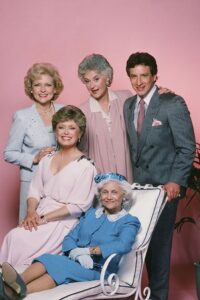
The ladies — a sarcastic substitute teacher, a Midwestern innocent and a sexually liberated Southern belle — are joined by the teacher’s 80-something Italian mother, and hilarity ensues. Over seven seasons they laugh together, face the challenges of aging together and eat enough cheesecake together to keep bakeries afloat.
The women’s names are Dorothy (Bea Arthur), Rose (Betty White), Blanche (Rue McClanahan) and Sophia (Estelle Getty), known as the Golden Girls, also the namesake of the popular TV show. With three proven sitcom pros (Arthur, White and McClanahan) and an acclaimed stage actress (Getty) in the leads, the series became an instant hit, known for its sometimes biting humor and its heartfelt depiction of female friendship.
In the history of television, there are few series that are still generating news almost 30 years after their last original episode. “The Golden Girls,” on NBC from 1985 to 1992, is the rare show that may be even more popular now than it was when it aired — thanks to syndication and streaming (available now on Hulu).
And “The Golden Girls” has a particularly large following in San Francisco, where it has been re-created on stage with drag performers in the leads since 2007. Instead of performing the show for an in-person audience at the Victoria Theater this year, “The Golden Girls Live! The Christmas Episodes” will stream live Thursday, Dec. 17, through Sunday, Dec. 20, with performers Heklina (Dorothy) D’Arcy Drollinger (Rose) Matthew Martin (Blanche) and Holotta Tymes (Sophia.)
But what is it about the show that has not only preserved its place in pop culture but also expanded its reach to the point where merchandise like shot glasses and face masks are now being produced? For Marsha Posner Williams, a producer on the show from 1985 to 1988 and the creator of the show’s title sequence, it remains one of the most popular sitcoms she worked on in a career that also includes hits like “Soap” and “Benson.”
“When people find out I worked on ‘The Golden Girls,’ even now, usually the first reaction I get is ‘Oh, I love that show,’” Williams says. “I’m not surprised. When it’s good, it’s very good, and the subjects are timeless.”
Williams says that the way the series approached issues surrounding women and aging remains one of its touchstones. Menopause, elder discrimination, Alzheimer’s disease, widowhood, late-in-life marriage and senior sexuality were all covered for the series — and they remain topical.

“You could be laughing in a scene and find you’re sobbing by the end,” Williams says. “It went to all those places.”
In some ways, it’s a pioneer.
“The Golden Girls” aired on NBC from 1985 to 1992 and maybe even more popular now than when it was originally broadcast.
Photo: NBC
“There was something different going on than we’ve seen before with how women over 50 on television were depicted,” says Sofie Van Bauwel, who has written about how the show treated aging bodies in mainstream culture. “They weren’t guests or supporting characters; they were the locomotive that drove the show.”
Van Bauwel says the only other series that approaches how “The Golden Girls” put older women in the show’s focus is Netflix’s “Grace and Frankie.” Given its popularity, she is surprised more series haven’t done the same.
While “The Golden Girls” fans span many demographics, the gay community has had an especially passionate kinship with the series. For Jim Colucci, author of the books “The Q Guide to the Golden Girls” and “Golden Girls Forever: An Unauthorized Look Behind the Lanai” the show wasn’t just “explicitly gay” with queer characters sometimes showing up as guests, but also implicitly gay with how it talked about chosen family and dealing with adversity.
“It was such a smart move because they were tackling subject areas that other shows didn’t dare and, therefore, they ended up having them all to themselves,” Colucci says. “Part of the reason they got away with doing that is because you can get away with older women who are already disenfranchised, already ignored by a lot of population, talking about these things.”
Growing up in the 1980s, Colucci says the show was his “gay fantasy about what life could be.”
“I wanted to live in a world where when somebody says something homophobic or insulting to you, you don’t think of the witty retort in the car on the way home, you think of it right there, and you flatten them with one line,” he says. “You look fabulous when you wake up at 2 in the morning to talk about your problems and eat cheesecake with your housemates who are all in perfect hair and makeup. They have dates every weekend with a different guy. This idea that wait, I could live with my three best friends and make each other laugh and defend each other to the end, they had the lives that we wanted to live.”
